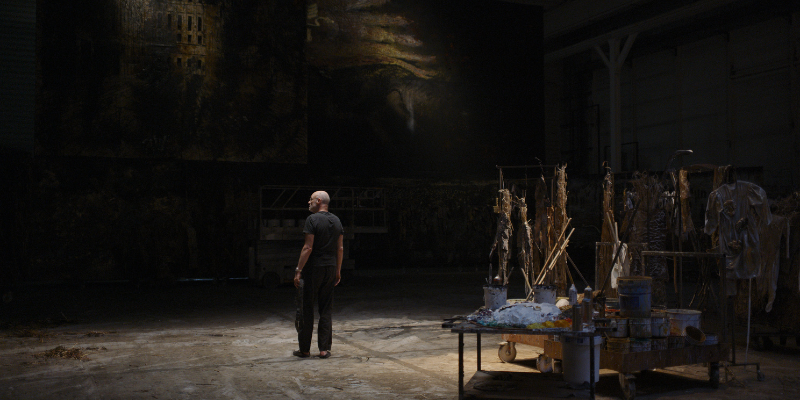Anselm | Rating: 4.5/5 | Reviewer: Sidonie Sturrock
Documentaries are often constructed as linear, fact-based narratives, presenting an objective series of events for viewers to digest. This format can be quite useful: it preserves dates, people, places, events, and dialog for the historical record and allows a wide audience to become better informed on a given topic. Multiple such documentaries have already been made about German artist Anselm Kiefer, a towering figure in 20th century European art known for his monumental paintings and sculptures with themes revolving around Nazism and the Holocaust. Anselm, filmmaker Wim Wenders’s 2023 documentary on Kiefer, takes the opposite approach to the straightforward narrative, favoring aesthetic reflection and subjective memory as its main points of focus.
The film opens quietly with Kiefer’s present-day work in his studio in Barjac, France. The camera transports us through the peaceful, sprawling estate where Kiefer houses various outdoor sculptures and installations. Dresses stand atop hills overlooking the pastoral landscape, stiffened by some kind of paint or plaster with sculptures of towers and planetary systems in the spaces where their heads would otherwise be. Soft, melancholic singing begins to fill the silence, as if emanating from these ghosts of history as they reach out to the present, to us.
Poetic reenactments of moments from Kiefer’s childhood and middle-adulthood, as well as clips of existing footage of his life, weave together with scenes of the artist at work in the present day, creating an approximation of his lived experience and living memory. Kiefer’s intellectual and artistic influences, from renowned poet Paul Celan, a Holocaust survivor, to various classical and biblical figures, punctuate the film via whispered voiceovers and the artist’s own references and quotations.
Though the film has an elliptical rather than linear form, the focus always returns to Kiefer’s current work at its center. He is shown working in multiple spaces, from his French property, to a studio in Buchen, Germany, to an old brick factory he purchased. We see him applying paint in broad, impasto fashion with a large spatula to canvases so massive they may as well be murals. Often, he mixes straw, cloth, and other materials into the paint to add greater weight and dimension. He aggressively hacks away at the paint once it has dried, revealing hidden layers underneath and creating an overall haggard surface. He goes to greater extremes still—burning the paintings with industrial torches, pouring molten lead over them, and leaving them outdoors to be weathered by the elements. The final results are breathtakingly haunting landscapes, sometimes snow-covered (or perhaps ash-covered) fields littered with dead flowers, sometimes mounds of mud marred by the tracks of tanks, other times calmly chaotic views of the night sky. Through this laborious process of alternating creation and destruction, Kiefer seeks to visually manifest an experience of historical build-up and erosion, memory and forgetting. In particular, he is concerned with the memory and forgetting associated with Nazism and the Holocaust, but he also engages with ideas about history on a grander scale, from antiquity to geological, cosmic time. (At one point he refers to a pit of clay dust in his brick factory studio as a kind of painting: chaos in a frame.)
While his current paintings and sculptures attempt to provoke with what he calls “subtle irritation,” Kiefer’s earlier work, which we are introduced to only later in the film, makes a more direct and jarring impact, often using outright depictions of Nazi gestures and architecture to make its interventions in a Germany that was still all but completely silent about its past. Though his approach has changed throughout his career, Kiefer has continued to ask viewers to consider what it could mean to take ownership of this history. Precisely because more and more of us have not lived through World War II and the living memory of it is waning fast, we cannot know with any certainty how we would have acted in that time. For that matter, we cannot be certain of how our activity in the present will affect the future, how history will view us—we cannot declare ourselves preemptively free from sin. Kiefer implies that, whether we like it or not, we inherit all of human history in the present, not merely the parts we wish to acknowledge as good or worthy, and it is our responsibility to remember it, seek to understand it, and, hopefully, to redeem it by creating a better world.
For director Wenders, it’s clear that this project is a deeply personal one. Wenders and Kiefer share strikingly similar backgrounds: both were born in West Germany in 1945, just as the Allied powers unleashed final defeat on the Nazis by bombing the country into literal ruins. Both boys’ formative years were spent playing among piles of rubble as their parents, family and teachers remained obstinately silent about the nation’s (and often their personal) fascist past. Both men began seriously pursuing creative careers at a young age and quickly found success in their respective fields of film and fine arts as they sought to fill historical and spiritual voids in their society. Both are now well into their late seventies, with far more years of artistic production behind them than in front of them. Wenders, a life-long Catholic, continues to be driven by his faith in the potential for ecumenical Christianity to alleviate the distress of modern social alienation and to redeem the tragic history of the 20th century—and now the 21st. To me, his latest film acts as a poignant, provocative message in a bottle about historical memory and the ever-present need for reflection and redemption.
Reviewers Note
P.S. For those unfamiliar with Wenders’s films, I would highly recommend first watching his most successful fiction films from the 1980s, Paris, Texas (1984) and Wings of Desire (1987). He also completed a documentary on Pope Francis in 2018, which I have yet to see—that, too, may be of interest.






